In The Composer's Voice, Edward T. Cone interprets musical compositions in terms of the various different "personae" which inhabit them. Regarding vocal music, his chief distinction is that between the singer (the "vocal persona") and the accompanist (the "virtual persona"); their synthesis is the "implicit" or "complete persona," equated with the "composer's voice" itself. He also suggests a parallel distinction between the "conscious" aspects of a singing character's motivation, and the many "subconscious" layers of knowledge and feeling which are articulated by the accompaniment alone.1 A central and fruitful aspect of this approach is its focus on the multiplicity of "personae" and their varying functions in different works. (I prefer to call these entities "agents," on the grounds that many essential forces in musical works have no associations with texts or characters;2 the "personae" thus comprise a subset of the larger class of musical agents. In certain contexts, Cone himself calls his personae "protagonists," implying a conceptual proximity to the notion of agency. I return to this subject below.)
Now in terms of the number of different agents involved, and the complexity of their relations, the richest of all musical genres is opera. In fact, a new conceptual and analytical paradigm seems to be emerging in recent operatic studies, which, following Harold S. Powers, I call "multivalence." An opera functions in numerous distinct domains; operatic form arises from patternings in these domains which often are not congruent and may even conflict; and these conflicts, far from being defects, are often a primary source of richness and meaning.3 According to this hypothesis, an opera does not and cannot exhibit "unity," at least as this concept has been understood by musical analysts in this century.
In The Composer's Voice, Cone discusses opera by analogy to lieder, distinguishing between operatic singers and operatic characters. The singers are always aware of the fact that they are singing, and that the noise emanating from the pit is but their accompaniment; but the characters they portray, according to commonsensical notions of dramatic consistency, cannot be aware of any such thing. (Cone makes an exception for circumstances equivalent to situations in spoken drama in which a character might be aware of music, such as when singing a serenade or reacting to a trumpet-call. [pp. 29-33] And in a recent essay,4 he propounds the radical hypothesis that operatic characters are aware of themselves as musical agents: "All operatic characters . . . know . . . that they live in a world of music, and that they express themselves and communicate with one another in song." [p. 132] Hence, in opera there is a fundamental . . . ambiguity . . . [as to whether] speech or song [is] being represented. . . . Expressive [and] realistic song . . . interpenetrate each other." [pp. 131-32] This argument seems to me problematical; for this reason, as well as because it may not yet be familiar to most readers, my remarks here are based primarily on The Composer's Voice.) Cone discusses opera only as a medium, in general terms; he comments on specific numbers only occasionally, and examines none in detail. This avoidance of sustained analysis is typical of opera studies. Nevertheless, his "multivalent" approach, suitably expanded, offers an important, as yet largely unrealized basis for operatic analysis in general. I will illustrate this thesis with respect to Pamina's aria "Ach, ich fühl's," from Act II of Die Zauberflöte. (Neither my analysis of the aria nor my description of its functions in the opera as a whole can do more than scratch the surface.)5
The context of "Ach, ich fühl's" is that Pamina has just been reunited with Tamino for the first time since the end of Act I, having in the meantime endured Monostatos's attempt on her virtue and her mother's charge to her that she assassinate Sarastro. But Tamino, who is undergoing the Trial of Silence, does not utter a word, and she falls into despair—that is, into song. (ex. 1) But Pamina is not only in despair, as her dissonant and chromatic melody abundantly demonstrates; she is also in shock: not focusing, not functioning. She sings primarily in short phrases, separated by rests; her longest phrase includes an inexpressibly desolate coloratura, almost keening with grief,6 just before the cadence in the middle. (m. 14) This joins with its opposite, those fragmented short phrases, to portray Pamina as inarticulate with grief. (Note the dramatic symmetry: Tamino wants to speak, but must not; Pamina wants to speak, but cannot.)
Example 1: Mozart, Die Zauberflöte, no. 17, "Ach, ich fühl's"
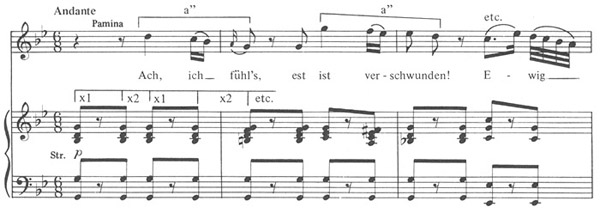
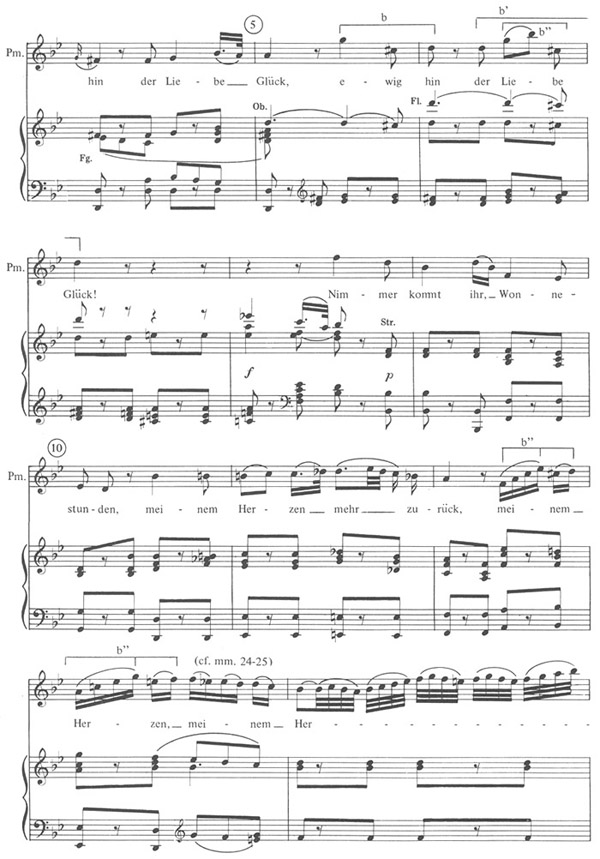
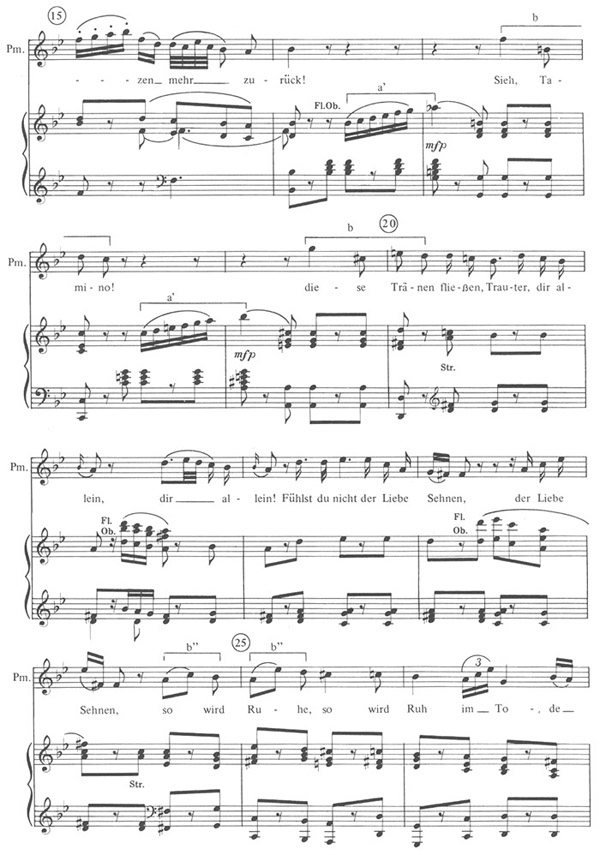
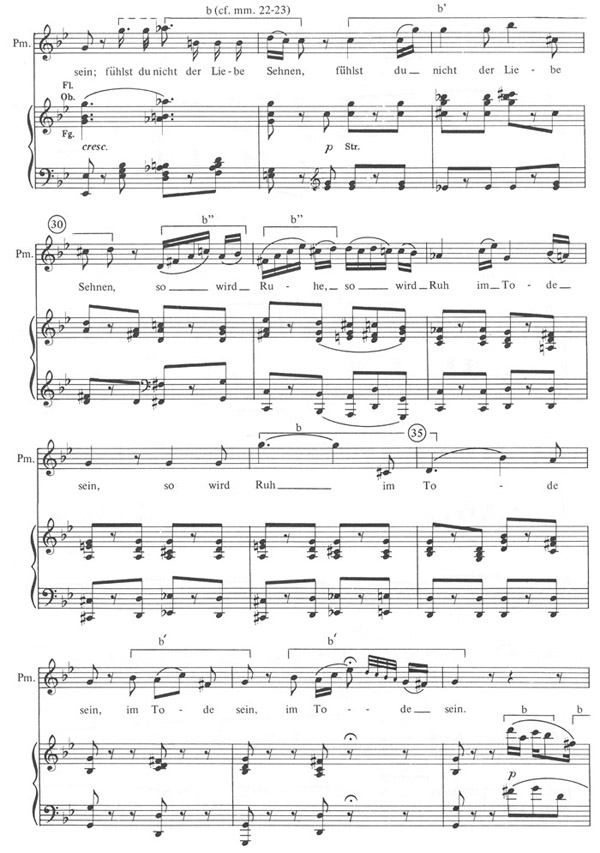
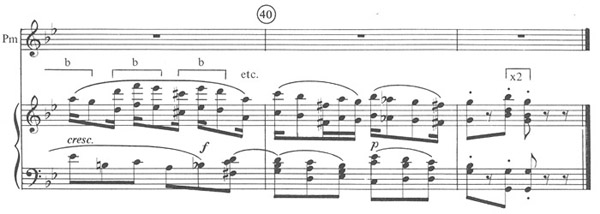
It is thus dramatically appropriate that her shock is also manifested to us by the orchestra, albeit in a different way. The accompaniment consists primarily of an ostinato in the strings, at once trochaic and iambic (marked x1 and x2 at the beginning of example 1), and thus having no single rhythmic profile; it is numb, undifferentiated. The long pulses on the beat are separated from the short upbeat ones by rests; this leaden, obsessive pacing mirrors the halting, disconnected rhythms of her vocal line. The accompaniment is as forlorn as Pamina herself; as long as she continues singing, it will remain trapped—in a state of shock. The same "dead" quality also governs the remarkable harmonic extensions towards the end: whenever Pamina tries to cadence, the orchestra, desolately prolonging the dominant, undermines her with a deceptive resolution. (mm. 27, 33) By contrast, the occasional melodic wind motives more nearly resemble Pamina's own. Thus the two agents, Pamina and the orchestra, are complementary: her primary mode of expression is despair, intermingled however with symptoms of shock; theirs is shock, punctuated by brief outbursts of despair. Each incorporates and reflects the nature of the other. (The same accompanimental pattern occurs in Pamina's Act I duet with Papageno, "Bei Männern," also in 6/8 and a moderate tempo.7 But this number differs from "Ach, ich fühl's" in that the introduction begins with a full group of three eighth-notes and includes the contrasting rhythm and timbre of the winds; and that, as a whole, the accompaniment is varied and flexible. On the other hand, the rhythmic similarity of the two accompaniments does establish a musical link, related to the dramatic theme of conjugal love: Pamina's despair at what she believes to be Tamino's coldness is the mirror-image of the bliss for which she and Papageno previously hoped. Such motivic correspondences among numbers are discussed further below.)
But her aria does finally come to an end, indeed with three successive perfect authentic cadences. (mm. 36-38) What, then, is the purpose of the long postlude, descending in such complex rhythms, so different from anything the orchestra played while Pamina was singing? (Among the arias in Mozart's non-seria Viennese operas, the only others with comparably "new" postludes are Figaro's "Non più andrai" and, to a lesser extent, Ferrando's "Un' aura amorosa" in Così fan tutte.8) A simple answer is that this is an exit-aria, and Pamina needs time to trudge offstage before the music has stopped. But this does not explain the special character of this postlude, or its change in the prevailing orchestral disposition of the aria.
The point is precisely Pamina's inarticulateness. Although her singing vividly projects her despair, it does not transform this emotion into a fully realized musical Gestalt. (Because of her shock, this is dramatically appropriate.) And so, after she can go on no longer, the orchestra speaks for her: the postlude expresses that which she can feel, but cannot say. (The effect is typical of instrumental epilogues which alter or transcend the singer's persona, as for example in many lieder of Schumann.) The postlude is longer than most of her phrases, entirely legato,9 without discontinuities, and with a new rhythmic flexibility. Moreover, it develops an important motive from Pamina's aria, labeled b in example 1. It appears first as the tritone g- (m. 5), part of an augmented-sixth chord, intensified in the next phrase to a diminished seventh; then in the retransition to the dominant (mm. 17-20), again with tritones, on "Sieh, Tamino" (her first words addressed directly to him). Finally, mm. 28-30 recall 6-7; in mm. 34-35 the tritone g-
(m. 5), part of an augmented-sixth chord, intensified in the next phrase to a diminished seventh; then in the retransition to the dominant (mm. 17-20), again with tritones, on "Sieh, Tamino" (her first words addressed directly to him). Finally, mm. 28-30 recall 6-7; in mm. 34-35 the tritone g- returns, converted and expanded into a diminished twelfth and lengthened; and the two final cadences again recall 6-7. Moreover, the postlude is based on this very motive.10 But as it almost cries out Pamina's words, "Sieh, Tamino, Tamino, Tamino," it transforms her disjointed utterances into a complex, coherent gesture, appropriate to her inner nobility and the high purposes of the opera. As a whole, the accompaniment thus develops like a character—just as Cone's theory predicts.
returns, converted and expanded into a diminished twelfth and lengthened; and the two final cadences again recall 6-7. Moreover, the postlude is based on this very motive.10 But as it almost cries out Pamina's words, "Sieh, Tamino, Tamino, Tamino," it transforms her disjointed utterances into a complex, coherent gesture, appropriate to her inner nobility and the high purposes of the opera. As a whole, the accompaniment thus develops like a character—just as Cone's theory predicts.
* * *
This postlude is thus an especially vivid manifestation of the "composer's voice"—of Mozart's own compositional persona. But this conclusion touches on a problematical aspect of Cone's method. Despite his analytical flexibility, he focuses primarily on individual songs, which he tends to interpret as unified, as utterances of a (single) controlling "complete persona." Even if this were to be granted, his corollary that "every opera is . . . an expanded song" (p. 21) seems untenable. An opera is a full-length musical drama, with a plot, action, lighting and scenery, costumed characters, motivations, public and ritualistic functions, and all the rest. Furthermore, in Mozart at least, every aria relates, on many different levels and in many different ways, to other numbers in the work of which it is a part; to ignore these relations in an analysis or interpretation necessarily leads to falsification. As far as opera is concerned, therefore, Cone's implicitly unifying theory runs counter both to common sense and to the new analytical paradigm of multivalence.
I cannot pursue this theoretical issue here. But I will suggest some respects in which Pamina's aria is related to, and must be understood in terms of, other numbers and larger themes in Die Zauberflöte.11 In doing this, I will also argue that there are more types of operatic agents than Cone describes: not only characters and accompaniments but, depending on the context, "purely musical" entities such as keys, motives, instrumental sonorities, textures, rhythms, prominent vocal pitches, and so on. The latter parameters are not necessarily "secondary," mere "articulations" of events in "primary" domains (characters and accompaniment); under certain circumstances they combine and associate in such a way as to become virtually autonomous. (This dynamic relation between primary and secondary elements of musical agency would seem to be related to the concept of "actant" in structuralist literary criticism.12 It also suggests an analogy to conventional analyses of instrumental music, in which pitch-relations and, to a lesser extent, rhythm are taken as primary, while other parameters such as dynamics, timbre, or register are relegated to secondary status. In both contexts, this implicidy hierarchical type of binary opposition cries out for "deconstructive" musicological criticism.) At least three aspects of "Ach, ich fühl's" relate to larger meanings of Die Zauberflöte and hence are agents in this sense: musical motives; the key of G minor; and the dramatic theme of the origins and purpose of the magic flute itself.
Some aspects of thematic continuity are shown in example 2. Several motives in Pamina's aria originate in Tamino's aria "Dies Bildnis," heard at the beginning of Act I. (ex. 2a)
Example 2a: Die Zauberflöte, no. 3, "Dies Bildnis"

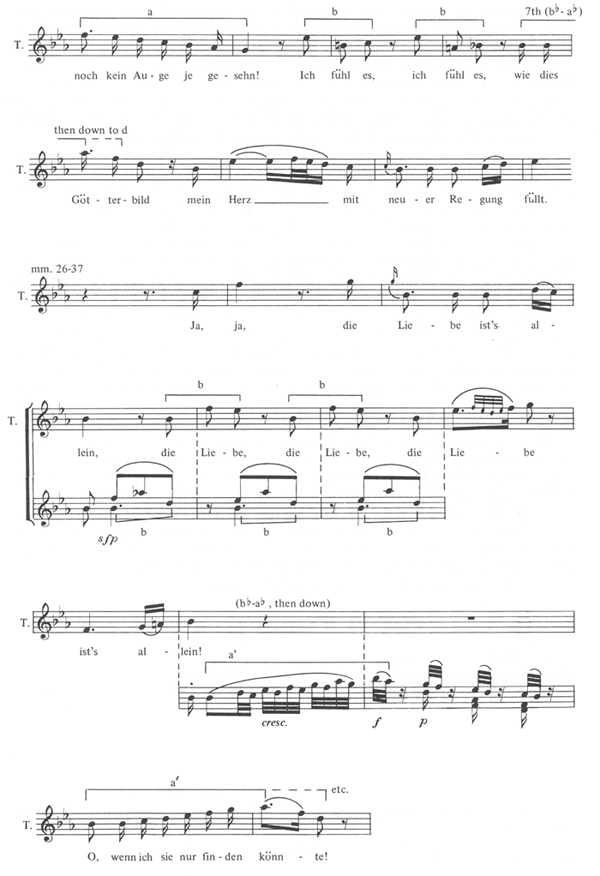
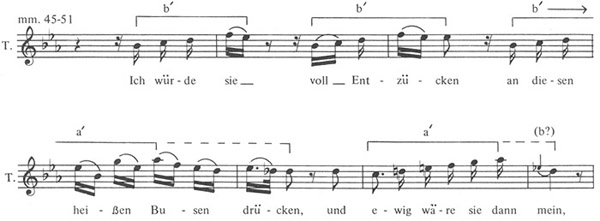
He begins with a descending scalar seventh from high g, labeled motive a. Soon thereafter, he introduces motive b itself, on the words "Ich fühl es"; later on (mm. 29-30), the same motive in inversion makes him realize what he is feeling: "die Liebe." Textually and musically, this motive articulates his love for Pamina. Still later (34 ff.), motive a appears several times in inversion (labeled a'), usually heading up a seventh from  to
to  '. Now these arias—the only ones sung by this central pair of characters—are directly related as dramatic opposites: Tamino falls in love with Pamina; Pamina believes that he no longer loves her. No wonder her aria, and especially its expressive postlude, center on the motive of his love for her! Note also that when she addresses him for the first time, using motive b on the words "Sieh, Tamino," (m. 17) his prominent rising A' appears poignantly in the flute and oboe, and at the same pitch-level,
'. Now these arias—the only ones sung by this central pair of characters—are directly related as dramatic opposites: Tamino falls in love with Pamina; Pamina believes that he no longer loves her. No wonder her aria, and especially its expressive postlude, center on the motive of his love for her! Note also that when she addresses him for the first time, using motive b on the words "Sieh, Tamino," (m. 17) his prominent rising A' appears poignantly in the flute and oboe, and at the same pitch-level,  -
- . Motives a and b also occur in many other passages having to do with conjugal love and Tamino's and Pamina's union; a few are shown in the remainder of example 2.
. Motives a and b also occur in many other passages having to do with conjugal love and Tamino's and Pamina's union; a few are shown in the remainder of example 2.
Example 2b: no. 7, "Bei Männern"

Example 2c: Act I, finale
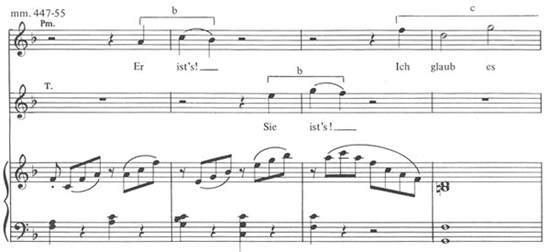
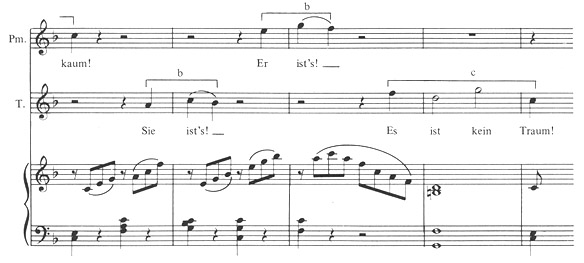
Example 2d: Act II, finale
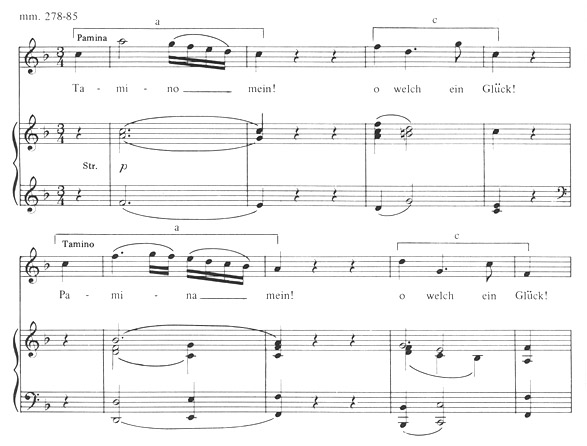
(Mozart had previously employed almost the identical progression to Pamina's phrase "Sieh', Tamino" at the analogous place in two other G-minor arias: Ilia's "Padre, germani," Idomeneo, No.1; [ex. 3a] and Konstanze's "Traurigkeit," Entführung, No. 10 [ex. 3b]. Like Pamina's phrase, both passages rise sequentially from B-flat to the dominant of G minor, as a transition between the two parts of a binary form. The latter even uses almost the identical tritone-motive b. Also in Idomeneo, Ilia's "Se il padre perdei," No. 11, includes an almost exact equivalent to Tamino's "Ich fühl es, wie dies Gotterbild," again in the same key and meter [ex. 3c; compare ex. 2a]. Indeed, what I have called motive b also appears in G-minor instrumental works of Mozart, often where there is an emphasis on  , most strikingly in the Andante of the G-minor Symphony, mm. 5-6. These inter-compositional associations do not "refute" the dramatic relevance of the motivic continuity within Die Zauberflöte; rather, they suggest that such figures were also "topoi," whether in Mozart's mind alone or more generally, for the expression of unrequited love.)
, most strikingly in the Andante of the G-minor Symphony, mm. 5-6. These inter-compositional associations do not "refute" the dramatic relevance of the motivic continuity within Die Zauberflöte; rather, they suggest that such figures were also "topoi," whether in Mozart's mind alone or more generally, for the expression of unrequited love.)
Example 3a: Mozart, Idomeneo, no. 1, "Padre, germani"
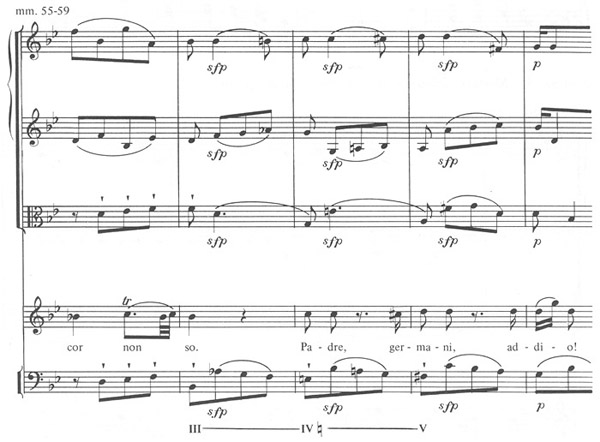
Example 3b: Mozart, Die Entführung aus dem Serail, no. 10, "Traurigkeit"
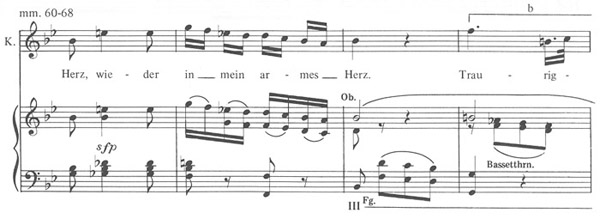
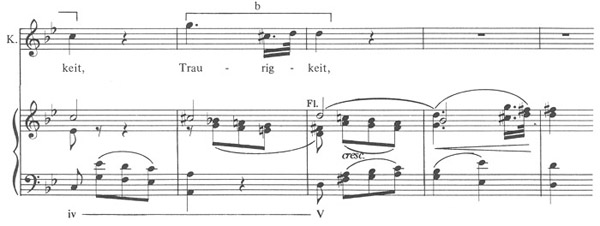
Example 3c: Mozart, Idomeneo, no. 11, "Se il padre perdei"
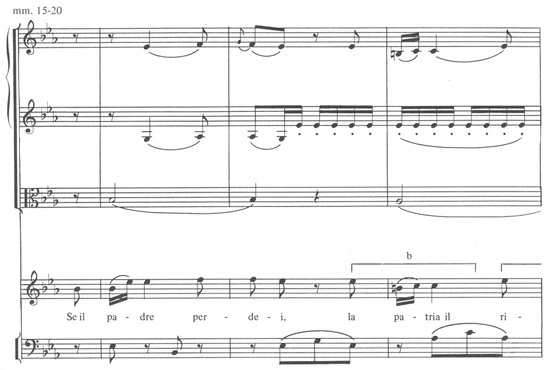
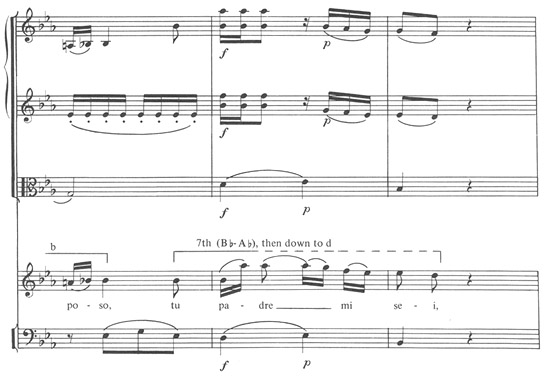
Individual keys can also function as agents. This has little or nothing to do with the chimera of "key-characteristics," or with "tonal structure"; but if a given key is distinguished by its manner of use or its dramatic contexts, it can assume "expressive" and "associative" meanings.13 Once established, such meanings can recur, whether in the same guise or altered; and such recurrences can contribute to the larger continuity. Regarding "Ach, ich fühl's," G minor is consistently associated with two linked characters and their primary emotions: Pamina and the Queen of the Night.
(Every discussion I have read takes the minor mode of "Ach, ich fühl's" for granted as a musical correlate of its dramatic context and expressive meaning. But it should not be taken for granted; except for those of the Queen of the Night, her mother, it is the only serious minor-mode aria for an important character in any Mozart opera from Figaro on [and even the Queen is not quite a real person]. Barbarina's cavatina in Figaro is a small item for a minor character. Alfonso's "Vorrei dir" in Così [in the same key] is duplicitous in intent and essentially comic; Ferrando's "Tradito, schermito" resolves to glowing major early on. Most remarkably, perhaps, there is not a single minor-mode aria in either Don Giovanni or La clemenza di Tito. Indeed, the only counterpart to Pamina's expressive G minor is the much earlier "Traurigkeit," in his other major German opera, Entführung.)
In this dramatic context, G minor first appears in the Queen's aria in Act I (No. 4:), where it becomes associated specifically with her relationship with her daughter. (ex. 4a) The number begins majestically in B-flat, and turns to G minor only at the end of the recitative, at the line "Das tief betrübte Mutterherz zu trösten." (This emphasis on "Mutter" will have later reverberations, as will the Neapolitan A-flat associated with it.) The first part of her aria, the sorrowful description of Pamina's abduction, then continues in the same key. Even if she is insincere or dissembling (as some have argued), the association of grief with G minor is thereby established. Her initial descent from D to G, marked a'' in example 4a, resembles Pamina's opening motive, on the same pitches; compare example 1.14 And, like "Ach, ich fühl's," this aria is sung to Tamino, who says—nothing. Mother and daughter are thus linked not merely by key, mode, and motive, but also by dramaturgical function, familial ties, and the Affekt of grief over the loss or absence of a loved one. These multiple similarities—and others could be added—establish G minor as a dramatic "agent" in Die Zauberflöte: the tonal projection of despair. (Compare two G-minor passages in the colloquy between Tamino and the Priest in the Act I finale: the Priest's rejection of Tamino's hotheaded claims, "Weil Tod und Rache dich entzünden" (mm. 93-94); and Tamino's later rejoinder, "Durch ein unglücksel'ges Weib bewiesen / das Gram und Jammer niederdrückt!" (mm. 118-20). The former implicitly refers to the Queen, for it is she who sent Tamino on his mission and whose motive is "death and revenge"—the latter, explicitly.)15
Example 4a: Die Zauberflöte, Act I, "O zittre nicht"
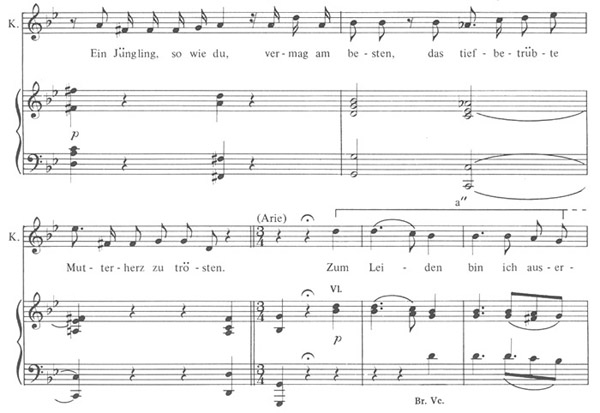
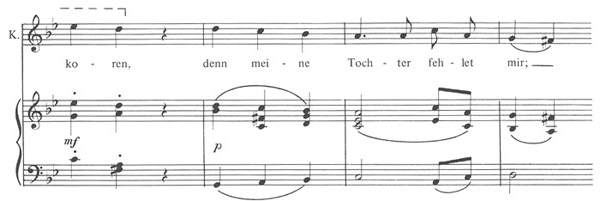
Example 4b: Act II, finale
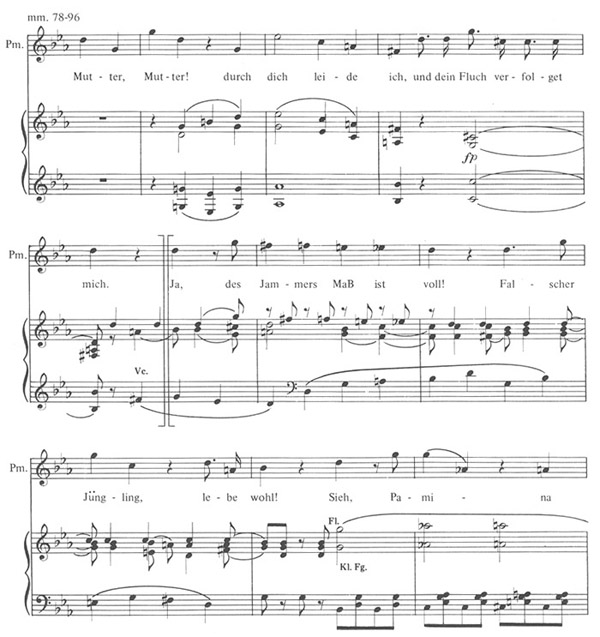
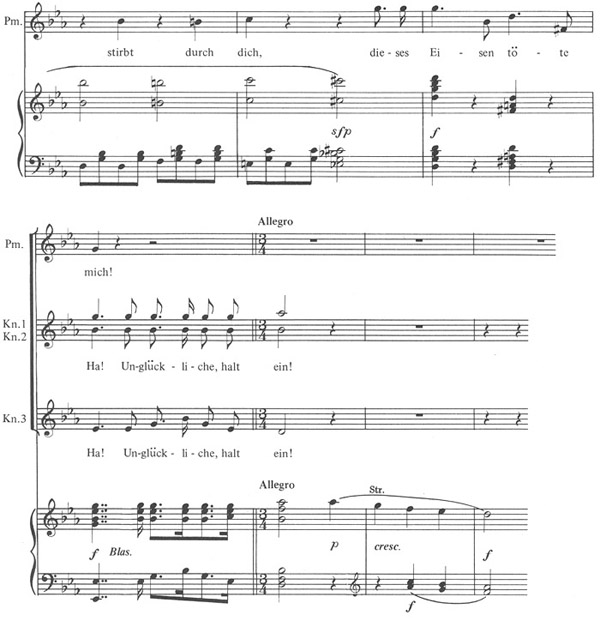
Example 4c: Act II, finale
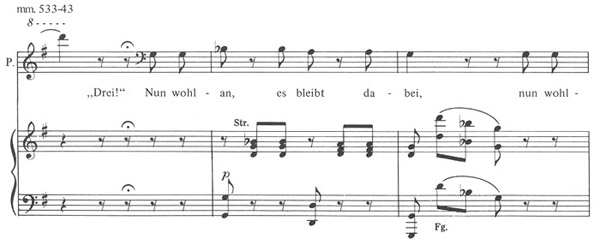
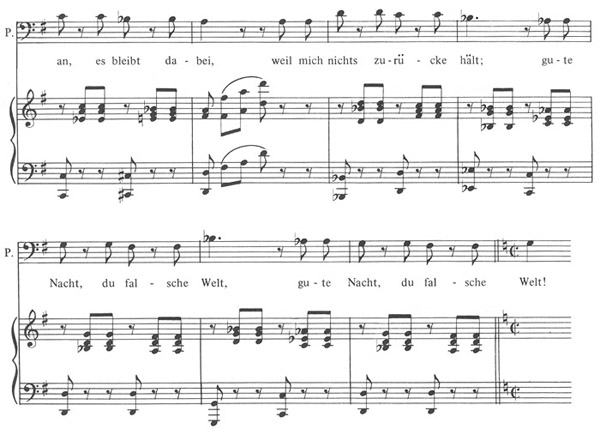
Example 5a: Die Zauberflöte, no. 4, "O zittre nicht"
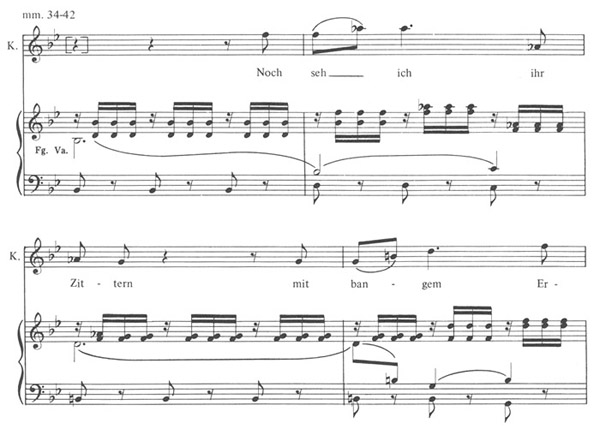

Example 5b: Act II, finale
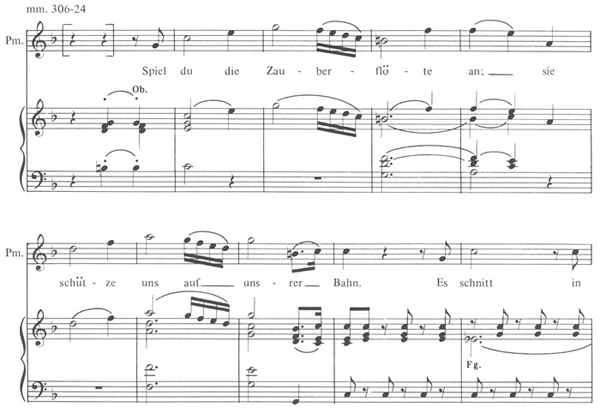
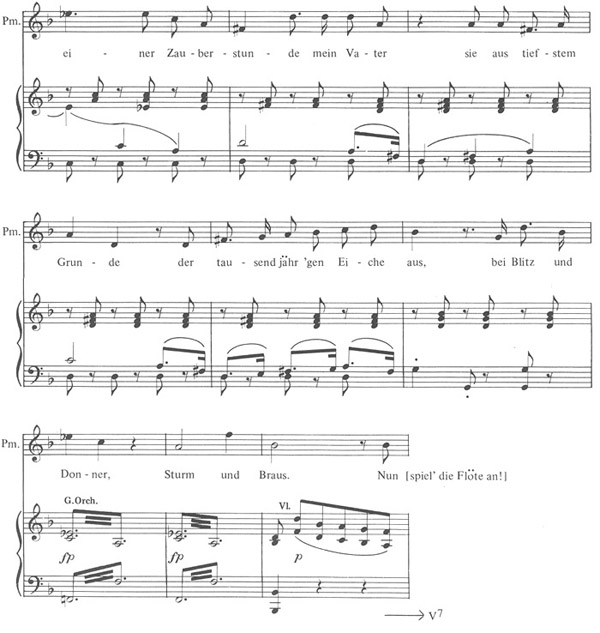
Example 5c: no. 17, "Ach, ich fühl's"
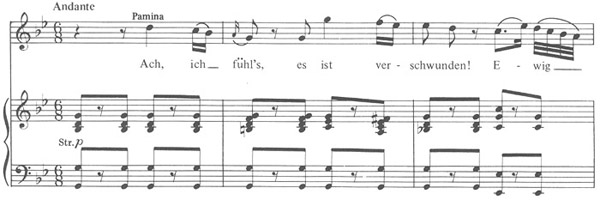
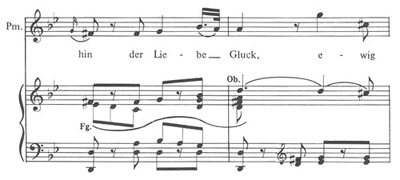
Two later appearances of G minor further develop this dramatic-tonal motive. During the finale of Act II, both Pamina and Papageno, believing themselves condemned to life without a loved one, contemplate suicide. Pamina not only modulates to G minor at her moment of crisis (ex. 4b), but does so precisely while invoking her mother's curse: "dein Fluch verfolget mich." Only the intervention of the genii prevents her from acting, as they deflect the G-minor cadence to E-flat, the key of this scene and the finale as a whole. (In the opposite context, Pamina's despair in "Ach, ich fühl's," the tonal relations were opposite as well: E-flat was the bass of augmented-sixth chords and deceptive cadences in G minor.) And although Papageno sings in the simpler key of G major, he too contemplates suicide in G minor. (ex. 4c) Again, the dramaturgy is parallel: the genii forestall him as well, with their (long overdue) advice to try playing his glockenspiel.
Finally, a different kind of dramatic theme—the origins and purpose of the magic flute itself—is suggested by two additional G-minor passages. They also share a single meter and tempo; more important, they share a striking musical texture, featuring a sinuous, chromatic obbligato bassoon as a middle voice. In addition, they share a crucial textual status: the words they set constitute a narrative—that is, an account of past events, told by one character to another, and "marked off" from the surrounding verbal context. Once again the Queen introduces this dramatic scene, in her first aria, as she describes Sarastro's abduction of Pamina. (ex. 5a) The other passage occurs at the climax of the entire action, as Pamina and Tamino are about to undergo the Trials. (ex. 5b) While telling him to play the magic flute for their protection, she digresses into the following remarkable narrative:
Es schnitt in einer Zauberstunde
Mein Vater sie aus tiefstem Grunde
der tausendjähr'gen Eiche aus
Bei Blitz und Donner, Sturm und Braus.My father, in a magic hour,
Carved it from the innermost heart
Of the thousand-year-old oak,16
In lightning and thunder, roaring storm.
Like the poetic and musical language of Tamino's colloquy with the Priest, this language is almost Wagnerian: it conjures a mythical time, when magic talismen were fashioned in the context of larger-than-life manifestations of Nature. But Mozart set these lines almost as a recall of the Queen's earlier plaint; note especially the bassoon part. The similarities of key, meter, instrumentation, texture, and the use of textual narration combine to create a dramatic "motive": the familial relations between Pamina and her parents, and their relations to the magic flute.
Indeed, this motive helps to clarify the most nagging problem in the libretto: the change of focus from Sarastro as evil abductor to enlightened ruler. At this climax in Act II, just before the Trials, we learn that the flute, which the Queen gave Tamino in order for him to rescue Pamina on her behalf, had actually been fashioned by her husband, long before. Earlier, just before her aria "Der Hölle Rache," the Queen told Pamina how her husband had enhanced Sarastro's rule, by bequeathing him his all-powerful, sevenfold-sun emblem. (This is the third significant textual narrative in the libretto—all three deal with Pamina's father or Sarastro; unlike the other two, it is not set to music.) Now we realize that it is his magic flute by which his daughter and her bridegroom will enter Sarastro's kingdom something that was denied to him, though he was a king. The flute thus not only provides for his dynastic succession (his daughter will be married to a ruling Prince), but also, in enabling Tamino to attain the status of Sarastro's eventual successor, ensures the viable continuation of the realm of enlightenment. Pamina's singing these words as a musical recall of her mother's earlier narrative, however, creates a direct link between Sarastro's abduction of her and her union with Tamino among the Elect. And this implies that Sarastro and her father must have plotted her abduction together!—as a means of forestalling the Queen's hegemony and ensuring Pamina's happy fate. Only Mozart's music articulates this dramatic implication.
It can even be heard in "Ach, ich fühl's" itself. There is a single obbligato bassoon motive early in the aria—it is the first music played by any wind instrument—over the first half-cadence (ex. 5c); it is of a piece with the two passages we have just heard. Even in her despair, Pamina subconsciously remembers her father and his magic flute—the agent of her hope for salvation.
* * *
These themes in Die Zauberflöte confirm Cone's thesis that the elements of music are agents, which have dramatic meaning. But they also suggest that it is impossible to deal adequately with any operatic number out of its larger context. Since the composer's "voices" differ so much from number to number, it seems unlikely that we will be able to describe a single controlling persona for an entire opera. On the other hand, these dramatic continuities do offer the prospect that detailed analysis of Mozart's operas—of anyone's—will lead not only to better understanding of them as musical entities, but also to more nearly adequate interpretations of them as dramatic works. Cone's grand hypothesis of musical agency will be an essential tool in carrying out this enterprise.
1The Composer's Voice, esp. chaps. 1-2.
2On "agency" in music, see the article by Marion A. Guck in this collection of essays; and Fred Everett Maus, "Music as Drama," Music Theory Spectrum 10 (1988).
3I survey these issues in "To Understand Verdi and Wagner We Must Understand Mozart," 19th-Century Music 11 (1987-88), esp. Section I. Powers coined the term "multivalence" in an unpublished study of Verdi's Otello, presented at a conference on Verdi and Wagner at Cornell University in 1984.
4"The World of Opera and its Inhabitants," in Music: A View From Delft, ed. Robert Morgan (Chicago, 1989), 125-38.
5In addition to the discussions in standard works like Hermann Abert's W A. Mozart and, recently, Stefan Kunze, Mozarts Opern (Stuttgart, 1984), see Rudolf Kelterborn, "W. A. Mozart: Der zweite Satz des Klavierkonzertes Es-dur KV 271 und die g-moll-Arie der Pamina aus 'Die Zauberflöte' (eine vergleichende Analyse)," in Musikreflektionen, vol, 1 of Beiträge zur musikalischen Analyse (Winterthur, 1987), 63-80.
6I owe this happy formulation to Wye Jamison Allanbrook.
7Might the ambiguous, iambic/trochaic nature of this motive be related to Mozart's famous uncertainty as to the metrical organization of "Bei Männern"? (On his revision, see NMA II/5/19, xvii-xviii, and the references given there.)
8On "Non più andrai," see my "To Understand Mozart," 181.
9The long autograph slurs, non-congruent in the different parts, imply a kind of "super-legato," carrying through unbroken to the piano in m. 40b. (In example 1, I have adjusted the left-hand slurs in the [generally very accurate] Peters vocal score to reflect the autograph more closely. It has been published in facsimile, edited by Karl-Heinz Köhler [Berlin, 1979], and is more or less accurately reproduced in the NMA.)
10The sharp-eyed Abert noted this motivic connection; see W A. Mozart, 2 vols. (Leipzig, 1956), 2: 669.
11This section has benefited from suggestions by Elizabeth Hudson, Mary Hunter, Roger Parker, and Richard Will.
12See, for example, Jonathan Culler, Structuralist Poetics (Ithaca, 1975), 82-83, 233-35; and Peter Brooks, Reading for the Plot (New York, 1984), 14-17.
13See Robert Bailey, "The Structure of the Ring and its Evolution," 19th-Century Music 1 (1977-78): 511ff.
14Noted independently by David Cairns, "A Vision of Reconciliation," in The Magic Flute: Wolfgang Amadeus Mozart (London and New York, 1980), 22, 39. (English National Opera Guides, III.)
15For analyses of this scene, see Rodney Farnsworth, "Tamino at the Temple's Portals: A Literary and Musical Analysis of a Key Passage from Die Zauberflöte," Canadian Review of Comparative Literature 4 (1981); Christoph Wolff, ". . . Zum Verständnis der Sprecherszene [in der] Zauberflöte," in Analysen: . . . Festschrift . . . Hans Heinrich Eggebrecht . . . , ed. Werner Breig et al. (Stuttgart, 1984), 234-47; and Webster, "To Understand Mozart" (see note 3 above), 185-90.
16Or possibly, for the second and third lines: "Carved it, for the profoundest reason, from the thousand-year-old oak"; that is, taking "tiefster Grund" as "profoundest motivation" instead of "inner-most heart[wood]," and altering the syntax accordingly. (The sense given in the main text is assumed in all German commentaries and English translations I have consulted.)


